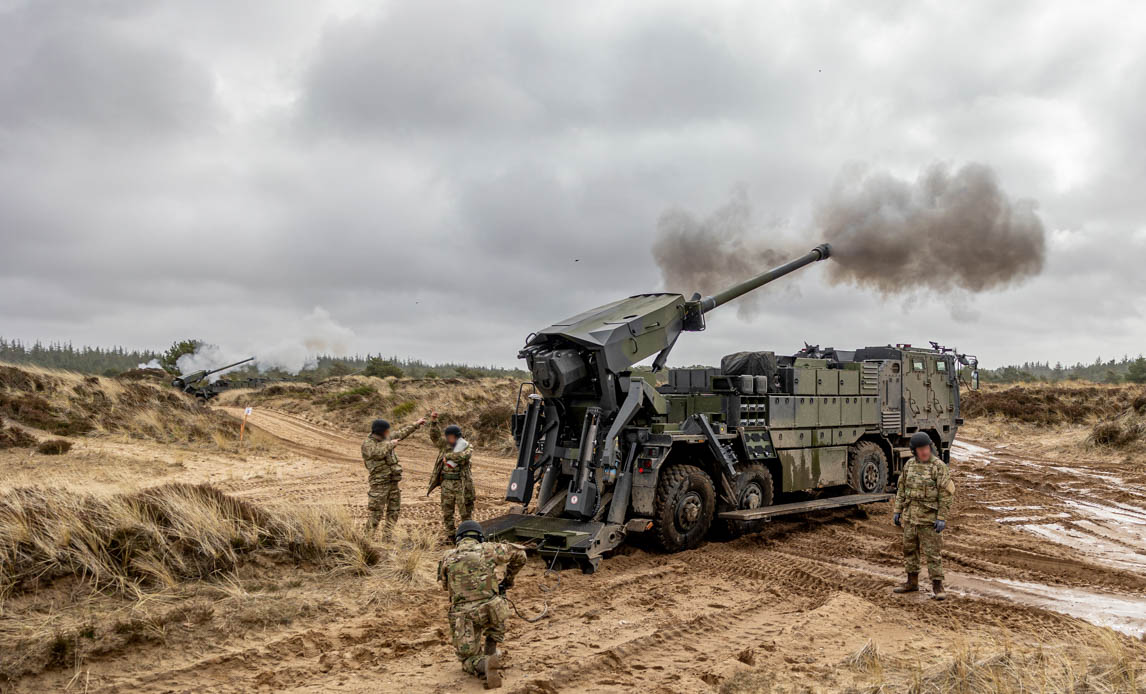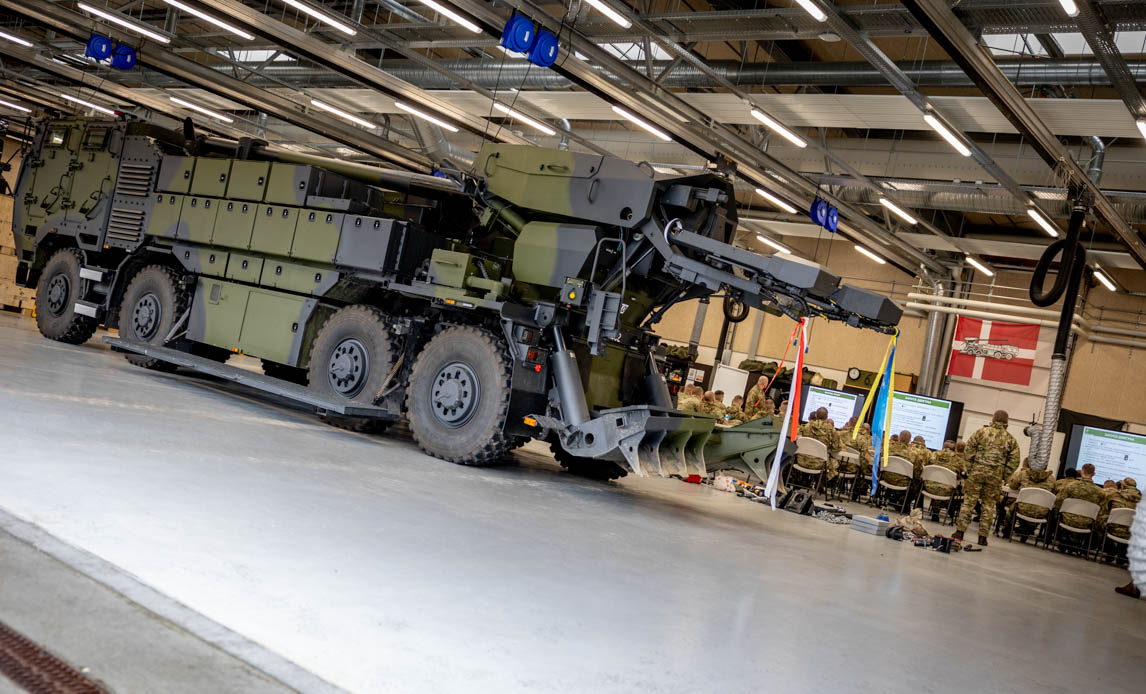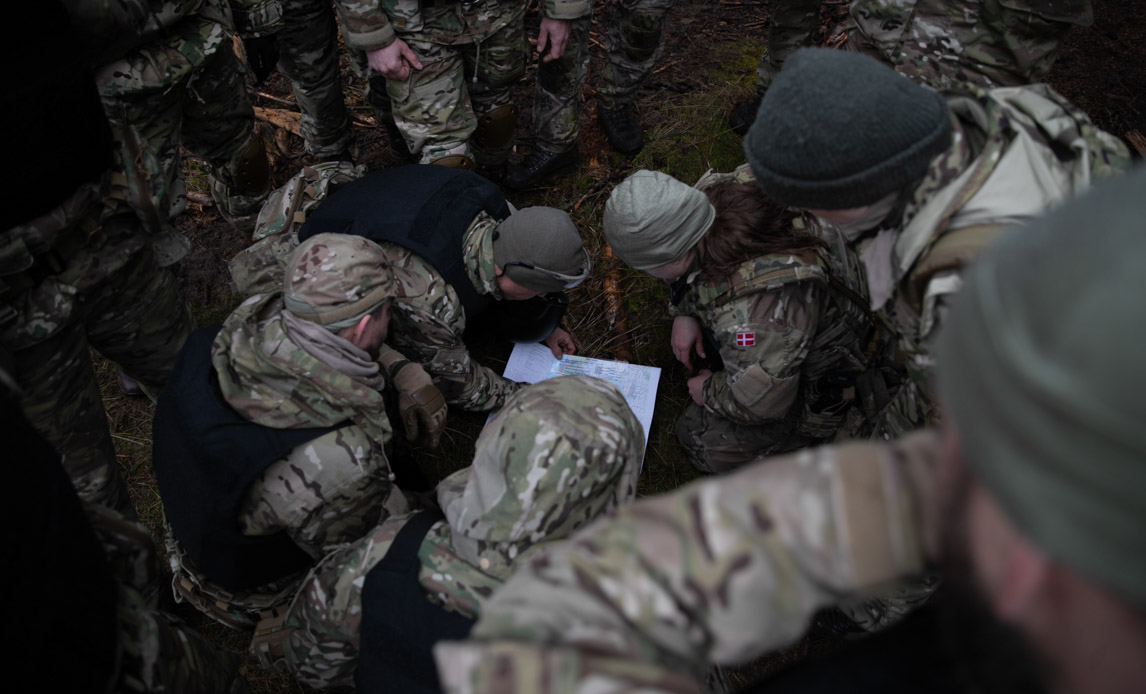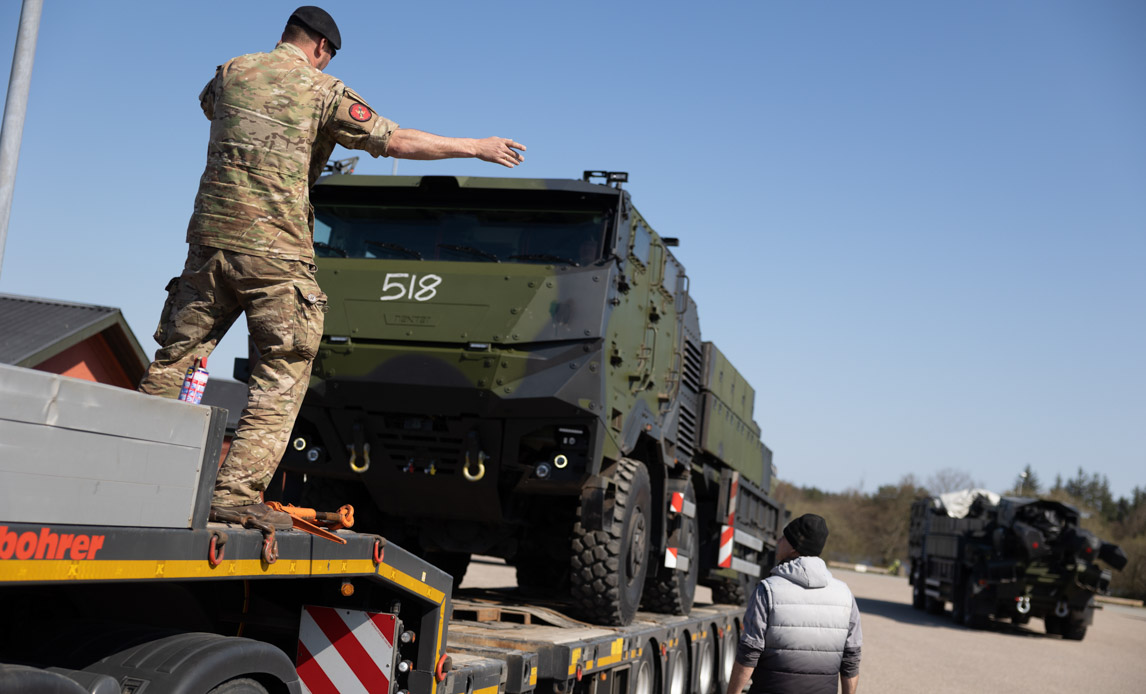Ukrainian soldiers trained on Danish artillery pieces
It was a large and complex task, as instructors from the Armed Forces, primarily from the 1st Artillery Department, trained Ukrainian soldiers at short notice and under great time pressure to use the Danish artillery system Caesar, which Denmark has donated to Ukraine. Now both artillery pieces and Ukrainians are at home in Ukraine to defend their homeland.

Shooting with the Caesar-artillery during the training. Foto: Danish Defence
By the Danish Defense Command
On Monday morning in mid-March 2023, the Ukrainian artillerymen and the Danish instructors met each other for the first time. Outside the rain poured down while the Ukrainian artillerymen sat in long rows in a large hangar in front of one of the 19 Caesar artillery pieces. The Ukrainian artillerymen had to get familiar with and trained on the new artillery system in a short time. They had all been trained on the Ukrainian artillery systems.
In front of them they were looking at the Danish instructors and into three weeks of intensive training in using and operating the Caesar artillery pieces. A compressed training process that meant long working days and no weekends.

It had all started a few months before on 19 January, when the Danish government and Parliament decided to donate all Danish Caesar 8x8 artillery systems to Ukraine. The donation was supposed to strengthen Ukraine's defense against the Russian occupation.
Massive training – also by our own people
The Caesar artillery pieces are state-of-the-art military equipment that can fight the enemy effectively, accurately and at long distances. Therefore, it requires a great deal of training for the soldiers operating them.
It placed great demands on drivers, soldiers and instructors from the 1st Artillery Division, who planned and carried out the compact training courses.
From the time the Parliamentary decision was made to the completion of the training and the donation, a very short time passed. Here, the instructors and soldiers from Oksbøl had to go through an intensive self-training in the Caesar, so that they were ready to train the Ukrainians.
The artillery were only fully tested in the fall of 2022 and planned to be officially handed over to the 1st Artillery Division in early 2023. This meant that the Danish instructors, regardless of several years of experience as artillerymen, first had to be fully trained on the Caesar 8x8 in parallel with the training being planned.
A number of instructors had also not taught via an interpreter before, which meant a training course from the Danish Defense Academy in this particular discipline. The sum of it all was that the 1st Artillery Division was very busy already months before the first Ukrainians landed at Oksbøl.
"It has been a big and important task for the Armed Forces and not least for the instructors at the Danish Artillery Regiment to solve. They hit the ground running, sprinting 12 hours a day for 2.5 months to train the Ukrainians. Everyone has solved the task well and I am proud of the help and support that the Armed Forces and everyone involved have given to Ukraine's defense struggle against Russia," says Chief of Defense General Flemming Lentfer.
The learning curve was steep for the Ukrainian soldiers, who had to learn to operate the system on their own over the course of three weeks.
"Our first impression was that it was some battle-weary young men who came to Denmark because they had been drawn directly from the front to Denmark. But they were very curious and incredibly motivated to learn and very, very clear about the training in Denmark on the Caesar-system," says the head of the 1st Artillery Department, Lieutenant Colonel Kenneth Riishøj, who was in charge of the training.
A joint task for the entire Armed Forces
In addition to the direct training of the soldiers who had to operate the Caesar, the Defense Maintenance Service was also busy. They had to get all the artillery pieces ready in record time, so they could be handed over to the Ukrainians. This meant, among other things, that Danish communication equipment had to be dismantled and that the machines had to be completely ready for use.
The Danish Artillery Regiment and the Defense Maintenance Service had a great deal of coordination and were in close contact throughout the process, so that the Caesar were fixed exactly in time to fit into the training course.
In addition, the maintenance service also trained Ukrainian mechanics so they can maintain and repair the system themselves in Ukraine.
Denmark has trained a total of around 100 Ukrainian soldiers, drivers and mechanics in the use of the Caesar artillery pieces.
The final part of the training of the Ukrainian soldiers took place in the terrain in Oksbøl. Here, theory and practice had to meet as a higher unit, when a combined target attack with several simultaneous artillery pieces was practiced. Several times over the course of two days, Caesar drove from a waiting position, where they hid in the forest and terrain, into a firing position, where they fired shots at targets several kilometers away in a short time, before quickly withdrawing.

An important link in the training - and one of the major challenges for both Ukrainian soldiers and mechanics - is the language. None of the Danish instructors spoke Ukrainian or Russian, and only very few Ukrainians could communicate in English. Thus the Defense Academy's language school provided interpreters who could translate the lessons and coordinate between Danish instructors and traveling Ukrainian interpreters.
According to the commander of the 1st Artillery Division, the donation and training of the Caesar artillery can have a great impact in Ukraine.
"They can deliver a great effect wherever they are deployed. It is clear that the front is very long, and the 19 Danish Caesars cannot solve the entire task, but they can make a difference to that extent," says Kenneth Riishøj.
CAESAR 8x8 155 MM HOWITZER
- Weight: 32 tonnes
- Length: 12.3 m
- Height: 3.1 m
- Width: 2.8 m
- Speed: 80 km/h on road – 50 km/h off-road
- Action radius: 600 km (when driving on the road)
- Caliber: 155 mm
- Rate of fire: 6 shots in less than 60 seconds
- Firing distance: 40 km (depending on ammunition type)
- Engine: V8 with 420 hp
Closing and donation
In mid-April the training was finished and on 20 April the first Caesar artillery pieces drove from Denmark towards Ukraine. The leaflets had been prepared and wrapped beforehand so that they did not attract attention on the roads towards Ukraine. A civilian transport company carried out the transport itself, but it was all escorted all the way to Poland by Danish soldiers from the Joint Movement and Transportation Organisation.

At the end of the training, instructors and leaders from the 1st Artillery Division could relax after completing the enormous training task in record time. Now they look forward to the Armed Forces, the Danish Artillery Regiment and the 1st Artillery Division receiving the new ATMOS and PULS artillery systems during 2023 and 2024.
Close cooperation with Ukraine
After Russia's invasion of Ukraine on 24 February 2022, Denmark has taken a major responsibility for supporting Ukraine in close cooperation with allies and partners. Both with training and donations of e.g. artillery, but also among other things with training of Ukrainian soldiers in Great Britain and Germany.
The Danish defense has supported and trained the Ukrainian defense since 2014 and has strengthened that effort since Russia's invasion of Ukraine in 2022. At the beginning of this year, the Danish Parliament decided that 19 Ceasar artillery systems should be donated from Denmark to Ukraine.
Timeline
- 19th of January: The Danish Parliament decides that all Danish Caesar artillery pieces should be donated to Ukraine. The donation will be accompanied by training and education.
- 19th of January: Planning the education and donation begins.
- 13th of February: The Defense Maintenance Service begins to prepare the first Caesar for use and donation.
- 16th of February: The training of Danish instructors begins at the Danish Artillery Regiment
- 28th of February: Nexter delivers the last Caesar artillery systems to Denmark
- 13th of March: The training of Ukrainian soldiers begins in Oksbøl
- 14th of April: The last Ukrainian soldiers, artillerymen and mechanics are trained
- 20th of April: The first Caesar artillery pieces travel from Denmark to Ukraine